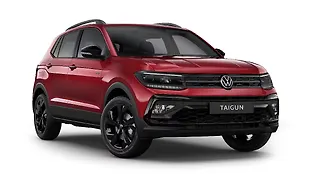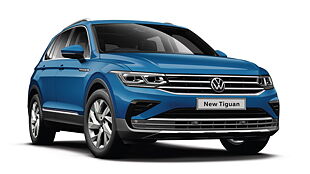What is it?
Why I would buy a Tiguan: A solidly built German SUV, which makes for a great alternative to the much more expensive Audi Q3 and BMW X1.
Why I would avoid the Tiguan: It is very expensive especially compared to the Hyundai Tucson, which is around the same size and packs good equipment too.

With the high price-tag, the Volkswagen Tiguan didn’t start on the right note. Expected to rival the Hyundai Tucson, its Rs 30 lakh plus price tag ended up it being compared to the ladder frame shod Toyota Fortuner and the Ford Endeavour. But going through the Volkswagen presentation, the German giant is aiming the Tiguan as a cheaper alternative to the Audi Q3, Mercedes GLA and the BMW X1. So does the Tiguan feel premium enough to justify the claim? We took it out for a long drive from Bengaluru to Chikkamagaluru to find out.
In its second generation, the new Tiguan is 33mm lower, its track has increased by 30mm, length has swollen by 60mm and it now sits on a wheelbase which is 77mm longer. This makes the Tiguan appear low and more planted. The wide grille with horizontal slats that gel into the LED headlamps further accentuate this effect. In profile the strong shoulder-line and mildly flared wheel arches breaks the monotony and lends it a strong stance. At the back the shapely tail lamps and the stubby boot lid are only two stylish elements in an otherwise plain design. Overall the exteriors of the Tiguan are understated but like with all VW cars will age well.
The new Tiguan is based on the modular MQB platform. It is mostly made-up of high strength steel and confers a front transverse engine layout and all-independent suspension via struts at the front and multi-links at the rear.
What is like on the inside?

Once inside the Tiguan, you might question the premium pricing as you see familiar bits from VW’s parts bin, many of which are also used on their affordable Polo hatch. But even in a car at this price point, none of the bits look out of place and it's a really nice place to be in. The dash design is simple, yet the chrome highlights and different textures help lift the ambiance.

Stepping in and out of the Tiguan’s cabin is a breeze thanks to the wide opening doors and ideal seat height. Getting comfortable in the snug driver seat is easy too, thanks to it being electrically powered with eight way adjustment. No such luck for the front passenger though, who gets manual adjust. Driving position in the Tiguan is well judged and thanks to the thin A-pillars and low window-line, you get an unobstructed panoramic view. Moving to the rear, the Tiguan is surprisingly spacious, with great under thigh and lateral support. The reclining backrest and plentiful headroom further add to the backseat experience. Despite being predominantly black cabin, the Tiguan feels quite airy and throughout the drive we never felt helmed-in or claustrophobic.

The boot at 615 litres is more than adequate and the well-shaped bay makes placing large bags easy too. You also get a 40:20:40 split folding rear seat which just adds to the car’s practical nature.

We had the top-of-the-line Highline trim on test and it came well loaded. It gets a large touchscreen system which features mobile mirroring, Apple CarPlay and Android Auto. The touchscreen itself works well and the graphics are modern too. You also get things like heated front seats, panoramic sunroof, powered tail gate, cruise control, three-zone climate control, ambient lighting, front and rear parking sensors with reverse camera and keyless go. As far as safety is concerned it comes with six airbags, pedestrian reactive hood (the bonnet raises by 3 inches to soften the blow) self-sealing tyres (takes care of small punctures) ESP and Airbags.
How does it drive?

The familiar VW 2.0 litre diesel engine from the EA189 engine family powers the Tiguan. Producing 141bhp and 340Nm of torque, this motor justifiably makes less power than the Audi Q3 which uses the same engine.
As soon as you step on the accelerator pedal you are greeted by a smooth getaway. This engine is incredibly linear for a diesel, which makes it very easy to drive. But where this engine feels strong till 3500rpm, the torque surge becomes flat post that and there is no point revving the engine hard as there is more noise than progress. This motor cruises well too and the tall seventh gear means the engine is running at a leisurely 1600rpm at 100kmph. The seven-speed dual clutch auto, also shared with the Audi Q3, works well in the Tiguan. With the Drive mode selector switched in Normal setting, the shifts are soft and seamless, and the gearbox is still decently quick to react to pedal inputs. In Eco mode, the ’box can’t wait to upshift, and it also coasts once off throttle for better efficiency. Put it in Sport however, and the gearbox and throttle response becomes noticeably more alert. Keep your foot in, and it won’t shift up until 4,600rpm. We managed to strap our Vbox timing gear and the numbers the Tiguan produced are par for the course. The Tiguan hits 100kph in 10.84sec and in-gear times of 6.69sec for 20-80kmph and 8.75sec for 40-100kmph are decent too. But where the Q3 with more power is much quicker, the cheaper Tucson also outdrags the Tiguan by a massive 1.6 seconds to 100kmph. The Tiguan’s engine isn’t as refined as the Hyundai’s too and on the move you always know there is a diesel motor working away.

The most impressive bit of the Tiguan is the reassuring feel you get at any speed. This Volkswagen SUV always feels planted and unfazed irrespective of the road condition or vehicle speed. Then there is the handling which is impressive too. The taut suspension lends the Tiguan great composure and even when pushed hard body roll is well contained. It also feels nimble in quick directional changes and the on-demand four wheel drive system guaranties massive traction at all times. On the downside the suspension does feel firm at low speeds and the ride is quite jiggly especially at the rear. Sharp edged bumps also tend to catch the suspension unawares as the Tiguan thuds through them. Sound insulation though is really good and there is precious little tyre or wind noise entering the cabin.

The Tiguan also comes with Snow and Off-road modes which alters the drivetrain and the four-wheel drive system for some mild off-road capabilities. We found the ground clearance to be more than enough too. Despite the claimed 150mm, not once we came close to scrapping the belly even with full load.
Should I buy one?

If you aspire to get a BMW X1 or the Audi Q3 and are running tight on a budget then definitely yes. This VW SUV oozes quality both inside and out. Apart from the engine, which could have done with more power, it matches or even betters the more expensive rivals in many respects. Obviously if you bring the Hyundai Tucson in the picture, the Tiguan seems too expensive but it does boast of better quality, more equipment and more sorted driving dynamics.
Where does it fit in?

The Tiguan prices start at Rs 27.98 lakh for the base Comfortline variant and go all the way up to Rs 31.38 lakh ex-Delhi. This makes the Tiguan similarly priced to the larger Toyota Fortuner and Ford Endeavour. But the Tiguan is a soft-roader and its main rival is Hyundai Tucson which is Rs 6 lakh cheaper and the Audi Q3 and the BMW X1 which are almost Rs 10 lakh more than the Tiguan.
Photos by Kapil Angane

![Volkswagen Tiguan [2017-2020] Exterior Volkswagen Tiguan [2017-2020] Exterior](https://imgd.aeplcdn.com/642x361/cw/ec/29422/Volkswagen-Tiguan-First-Drive-Review-98519.jpg?v=201711021421&wm=1&q=80)
![Volkswagen Tiguan [2017-2020] Exterior Volkswagen Tiguan [2017-2020] Exterior](https://imgd.aeplcdn.com/642x361/cw/ec/29422/Volkswagen-Tiguan-First-Drive-Review-98573.jpg?v=201711021421&wm=1&q=80)
![Volkswagen Tiguan [2017-2020] Exterior Volkswagen Tiguan [2017-2020] Exterior](https://imgd.aeplcdn.com/642x361/cw/ec/29422/Volkswagen-Tiguan-First-Drive-Review-98574.jpg?v=201711021421&wm=1&q=80)
![Volkswagen Tiguan [2017-2020] Exterior Volkswagen Tiguan [2017-2020] Exterior](https://imgd.aeplcdn.com/642x361/cw/ec/29422/Volkswagen-Tiguan-First-Drive-Review-98572.jpg?v=201711021421&wm=1&q=80)
![Volkswagen Tiguan [2017-2020] Exterior Volkswagen Tiguan [2017-2020] Exterior](https://imgd.aeplcdn.com/642x361/cw/ec/29422/Volkswagen-Tiguan-First-Drive-Review-98571.jpg?v=201711021421&wm=1&q=80)
![Volkswagen Tiguan [2017-2020] Exterior Volkswagen Tiguan [2017-2020] Exterior](https://imgd.aeplcdn.com/642x361/cw/ec/29422/Volkswagen-Tiguan-First-Drive-Review-98570.jpg?v=201711021421&wm=1&q=80)
![Volkswagen Tiguan [2017-2020] Exterior Volkswagen Tiguan [2017-2020] Exterior](https://imgd.aeplcdn.com/642x361/cw/ec/29422/Volkswagen-Tiguan-First-Drive-Review-98569.jpg?v=201711021421&wm=1&q=80)
![Volkswagen Tiguan [2017-2020] Exterior Volkswagen Tiguan [2017-2020] Exterior](https://imgd.aeplcdn.com/642x361/cw/ec/29422/Volkswagen-Tiguan-First-Drive-Review-98568.jpg?v=201711021421&wm=1&q=80)
![Volkswagen Tiguan [2017-2020] Image Volkswagen Tiguan [2017-2020] Image](https://imgd.aeplcdn.com/272x153/cw/ec/21615/Volkswagen-Tiguan-Right-Front-Three-Quarter-98786.jpg?wm=0&q=80)

























